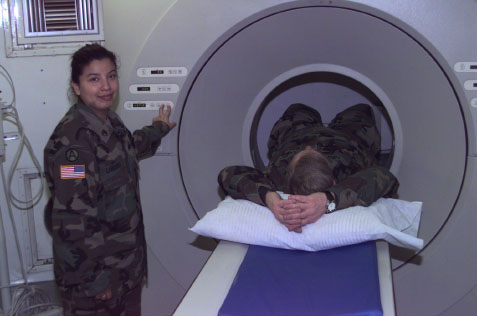DOT&E FY2000 Annual Report
Download Printable PDF Version
Comment on this Report
CORPORATE EXECUTIVE INFORMATION SYSTEM (CEIS)
 |
| ASD(HA) ACAT IAM Program | Prime Contractor | |
| Total Number of Systems: | 150 Sites | EDS and SAIC |
| Total Program Cost (TY$): | $423M | |
| Average Unit Cost (TY$): | $2.8M | |
| Full-rate Production (V1.0): | 4QFY97 | |
| Full-rate Production (V2.0): | TBD |
SYSTEM DESCRIPTION & CONTRIBUTION TO JOINT VISION 2020
The Corporate Executive Information System (CEIS) is a tri-Service system for integrating executive information support across the Military Health System (MHS). It will support the clinical, financial, and management needs of military medical treatment facilities (MTFs), tri-Service Health Care (TRICARE) Lead Agents, Service Intermediate Commands, the three military department Surgeons General, and the Office of the Assistant Secretary of Defense (Health Affairs) [ASD(HA)]. CEIS integrates commercial-off-the-shelf executive information and decision support systems. The executive information system offers a top-down view of the health care enterprise, integrating data from many sources, producing reports, and linking decision makers. The decision support system provides a single source of integrated, patient-level information to the health care enterprise, incorporating clinical, financial, and administrative data. There is a large active user community (over 7,000 users) within DoD, with user organizations ranging from small community hospitals to multi-facility health care enterprises.
The CEIS architecture includes two major groups of servers: (1) "data warehouses" of integrated data base servers housing repositories of health services data integrated from major MHS operational automated information systems; and (2) "data marts" of distributed servers housing patient-level care data and pre-approved information products that evaluate and assist in improving MHS. Currently, CEIS is based on a distributed client-server processing architecture built around TRICARE regional data bases fed by selected central data bases and data bases located at MTFs.
The core of the CEIS architecture is an open relational data base management system that fuses information into a single authoritative and consistent source. CEIS does not manufacture data; it extracts "evaluation" data from source data collection systems and integrates it in the data warehouse. Some of the source data collection system feeds are local to individual MTFs, while others are centralized systems serving multiple locations. CEIS supports Joint Vision 2020 by providing health care managers and providers with the capability to collect, process, and disseminate an uninterrupted flow of medical information. It enhances information superiority by providing decision makers with accurate information in a timely manner, allowing them to be more effective and efficient in providing health services.
BACKGROUND INFORMATION
CEIS is being acquired for the MHS by ASD(HA), with the Army Surgeon General designated as Executive Agent. The new system was originally intended to subsume the functionalities of eight legacy systems. Seven of these systems have already been turned off, and now CEIS has become the target system for the migration of all systems within the Executive Information/Decision Support area of the MHS. It is considered critical to the effective management of DoD's TRICARE program.
A Government Installation and Acceptance Test (GIAT) was conducted in June 1997. This was a two-phase, combined DT/OT effort. Army Test and Evaluation Command (ATEC), the independent OTA, participated in the first phase of the GIAT, observing DT&E and gathering selected information for assessment. ATEC then conducted a dedicated OT in June and July 1997, with most of the data provided by the users. During this phase, ATEC collected operational data at 14 test sites and conducted user desk audits for qualitative data. ATEC also evaluated the quality of system manuals and documents.
Although CEIS has undergone several incremental enhancements since 1997, it has not changed substantially. During this period, ATEC continuously evaluated the system and performed risk assessments, which determined that full OT&E would not be required until the next major release, CEIS 2.0. Development of CEIS 2.0, however, was delayed indefinitely by problems associated with creating an Enterprise Data Warehouse (EDW) to replace the regional data bases. A single EDW could not be designed to provide reliable data, and a new system architecture had to be developed.
TEST & EVALUATION ACTIVITY
In June 2000, AEC and the U.S. Army Medical Department Board (AMEDDBD) performed an OA of the incremental release CEIS 1.10. This is an enhancement known as the All-Region Server (ARS) Bridge, which provides a trans-regional aggregate view of cost and treatment data to the top three levels of users. ATEC and AMEDDBD conducted the OA in Falls Church, VA, and concluded that the ARS Bridge was operationally effective, but not operationally suitable due to training deficiencies. DOT&E concurred. Recommendations were provided to improve the web-based training and on-line manuals.
TEST & EVALUATION ASSESSMENT
The 1997 IOT&E was very positive for an emerging system. Combined DT/OT proved to be a very effective testing methodology for CEIS, as it can be for other automated information systems. For a system like CEIS, in which both DT and OT took place at a relatively large number of test sites (14 MTFs), much of the DT data could also be used to evaluate performance in the operational environment, particularly since it was supplemented by information obtained directly from the users. In the case of CEIS, it was possible to obtain most of the quantitative data electronically; and with combined DT/OT, the cost of testing (both dollars and people) was significantly lower than it might have been.
Despite the early success of CEIS 1.0, development of CEIS 2.0 did not go as planned because of deficient system architectural design and unsettled functional requirements. The program is now being re-baselined, and a new TEMP will be required. Nevertheless, the same combined DT/OT testing methodology that worked well with Version 1.0 and its enhancements should be effective with Version 2.0 as well.
FY00 CORPORATE EXECUTIVE INFORMATION SYSTEM (CEIS)
|
NEWSLETTER
|
| Join the GlobalSecurity.org mailing list |
|
|
|

